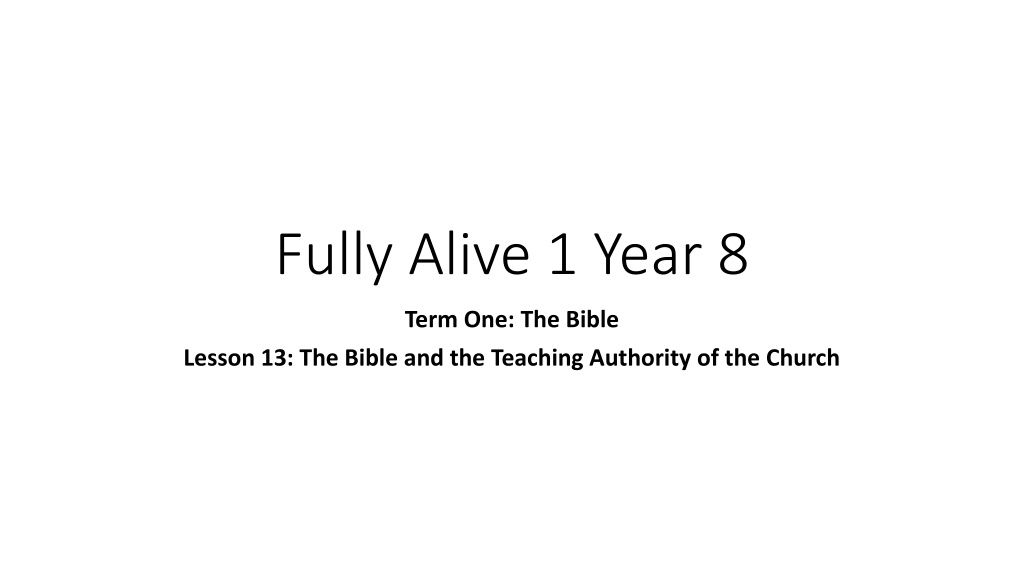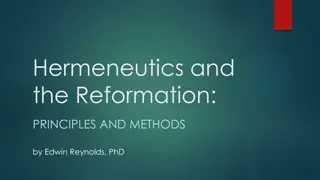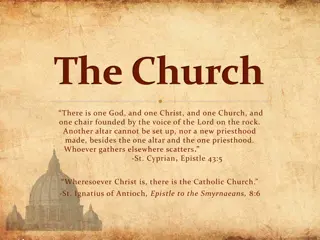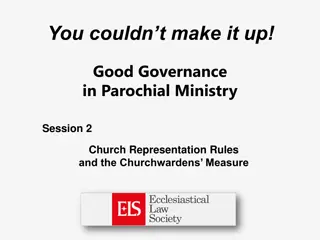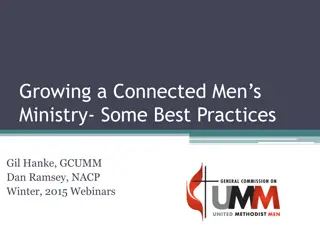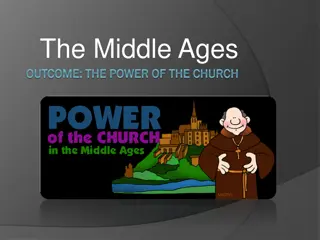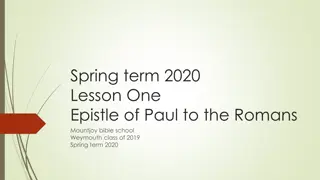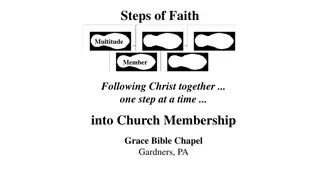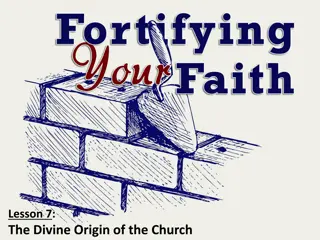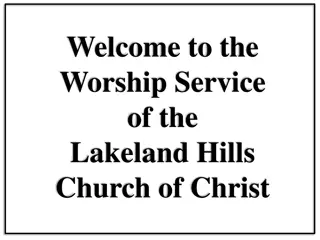Understanding the Context of Bible Stories and Church Teachings
Explore the importance of context in understanding Bible stories and church teachings, including discussions on Magisterium, Sacred Tradition, and the role of the Church in interpreting scripture. Learn how context enhances our comprehension of religious texts and traditions. Delve into examples highlighting the significance of context when reading biblical passages. Discover how the Church emphasizes the consideration of historical and cultural contexts in interpreting sacred texts.
Uploaded on Sep 12, 2024 | 0 Views
Download Presentation

Please find below an Image/Link to download the presentation.
The content on the website is provided AS IS for your information and personal use only. It may not be sold, licensed, or shared on other websites without obtaining consent from the author. Download presentation by click this link. If you encounter any issues during the download, it is possible that the publisher has removed the file from their server.
E N D
Presentation Transcript
Fully Alive 1 Year 8 Term One: The Bible Lesson 13: The Bible and the Teaching Authority of the Church
Learning Intentions In this lesson you will be learning about: why it is important to understand the background or wider circumstances (context) of the stories in the Bible; the meaning of the terms Magisterium and Sacred Tradition; the role of the Church in accurately interpreting Sacred Scripture and safeguarding Sacred Tradition. 2
Breaking News Mary Immaculate Slaughters Loreto Mary Immaculate Slaughters Loreto Holy Child Annihilates Sancta Maria 3
What does context mean? Context is the word we use for the background details or wider circumstances that need to be taken into account before we judge something at face value. It is often necessary to know the context in order to understand the real meaning of something, and so avoid misinterpreting what it is about. This has been illustrated by the example of the newspaper headlines naming school sports teams and by the stories you have shared about your own experiences of misinterpreting things. 4
Context and the Bible Sometimes when we read a passage from the Bible, we might be confused about what exactly the story is about or what message it is communicating to us. We need help to understand the wider situation or circumstances, or the context, within which the passage was written. Just as knowing what the names in the newspaper headlines referred to helped us to understand their actual meaning, the same is true when it comes to the Bible. 5
An example of considering context when reading a Bible passage Let s look at an example. In the Gospel according to John there is a story about a Samaritan woman meeting Jesus at a well and having a conversation with him. The whole point of this story is missed if you don t know that there was great tension between Jews and Samaritans at that time in that country, and that many men of that time regarded women as inferior to men. So the very fact that Jesus, who was a Jew, had a conversation with a Samaritan woman was, in itself, a big deal and something quite extraordinary. 6
The Church teaches The Church teaches In order to discover the sacred authors intention, the reader must take into account the conditions of their time and culture and the modes of feeling, speaking and narrating then current. (Catechism of the Catholic Church, paragraph no. 110) 7
Sacred Tradition and the Magisterium Before his death, Jesus promised to send the Holy Spirit to the leaders of the early Church (Peter and the other apostles) to help them to continue the work that he had begun. The Holy Spirit came to the leaders of the early Church at Pentecost. The same Holy Spirit continues to guide and inspire the leaders of the Church today. That is why we turn to the leaders of the Church for guidance in understanding the Bible and what God is communicating to us through its sacred writings. Sacred Tradition is the term used to describe all the teachings of the Church that have been handed down through the ages from the Apostles to their successors, the Pope and the bishops. The Pope and the bishops, guided by the Holy Spirit, are the teaching office of the Church. The official name for this teaching office of the Church is the Magisterium.The word magisterium comes from a Latin word that means teacher . The role of the Magisterium is to give the correct and accurate interpretation to the Word of God contained in both Sacred Scripture and Sacred Tradition. 8
Sacred Tradition and the Magisterium (continued) Over the last two thousand years, Church leaders and scholars have studied, celebrated, prayed with, meditated upon and written about the Bible and its stories. This represents a great spiritual wisdom passed on through the centuries. This is why, when reading the Bible, we need to listen to the faith of the Church, to her teachings and Tradition. We also need to learn from the archaeologists, the historians and the language experts. Without such help, we are in real danger of misinterpreting the Bible s meaning and misleading ourselves and others. With the help of the Church, we can hear the authentic Word of God and be helped to understand its meaning for our lives today. 9
The Church teaches The task of giving an authentic interpretation of the Word of God, whether it is in written form or in the form of Tradition, has been entrusted to the living teaching office of the Church [the Magisterium] alone. Its authority in this matter is exercised in the name of Jesus Christ (Constitution on Divine Revelation, no. 10). This means that the task of interpretation [of Sacred Scripture and Sacred Tradition] has been entrusted to the bishops in communion with the successor of Peter, the bishop of Rome. (Catechism of the Catechism of the Catholic Church, paragraph no. 85) 10
A time to pray Sign of the Cross Teacher In this lesson we have discovered that knowing and understanding the context within which a particular story from the Bible was written can help us to truly grasp its meaning. A good example of this is the story of Jesus curing a man with leprosy, which is found in Mark s Gospel. Let s listen to that story again now. Reader A man suffering from a dreaded skin disease came to Jesus, knelt down, and begged him for help. If you want to, he said, you can make me clean. Jesus was filled with pity, and reached out and touched him. I do want to, he answered. Be clean! At once the disease left the man, and he was clean. (Mark 1:40-42) 11
A time to pray (continued) Teacher Leprosy is a serious skin disease that still exists today. It is easily spread from contact with an infected person. It causes numbness and terrible sores on the skin, but particularly on the face, hands and feet. At the time of Jesus, there was no cure for this disease. People who had the disease were cast out of their homes and villages and no one would go near them. People often threw stones at them to keep them away. If they went into a village to collect food, they had to ring a bell and shout unclean so that people could run inside to avoid them. Given that we now understand how dangerous and contagious leprosy is, it may help us to appreciate Jesus treatment of the man who was suffering from this disease. Jesus did not hesitate when the man asked him for help. Jesus reached out and touched the man. He was tender and kind. He saw past the terrible disease to the person inside. Let us pause for a moment and imagine the scene that day when the man suffering from leprosy approached Jesus. Concentrate on Jesus. What does he say to the man? (Pause) What does he do? (Pause) What is the message of this story for us today? (Pause) 12
A time to pray (continued) Teacher Together let us pray: All Jesus, you are our friend. You care for us. You will not turn away from us. You will be there for us in our times of need. We only need to call out to you and ask for your help and we will feel your healing touch. Thank you, Jesus, for your love. Help us to show compassion and kindness to others as you did, Especially to those most in need. Amen. Sign of the Cross 13
